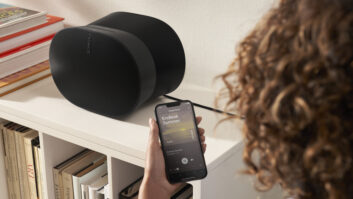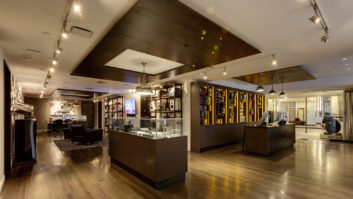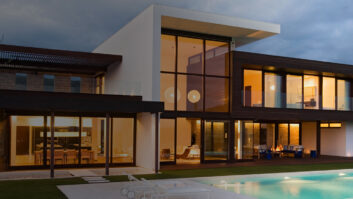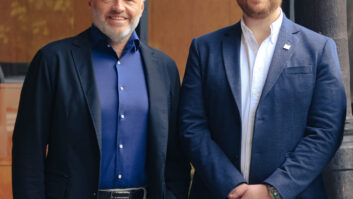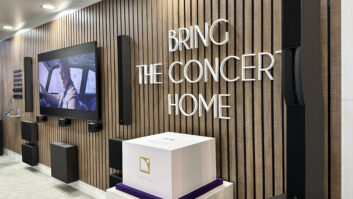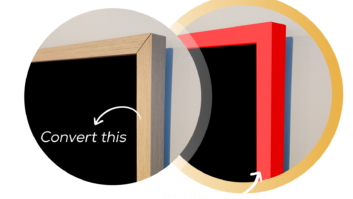Snell Acoustics is a rare breed. During 32 years of operations, the Massachusetts manufacturer has remained innovative without sacrificing quality or craftsmanship. Since it was acquired by D&M Holdings in 2005, Snell has been developing a campaign to modernize its identity while honoring its hi-fi roots. Last week, I visited its Peabody, Massachusetts, headquarters (which it also shares with Boston Acoustics) to learn more about Snell’s plans to expand its network of dealers (approximately 200 domestically) and its global footprint. I also went for a sneak peek of the new flagship tower designed by Joe D’Appolito. Dubbed The Illusion, the new speaker will ship this Spring and offers the horsepower and a design so radical Snell thinks it will redefine category.
Snell offers sound solutions for most high-end budget and performance needs (floorstanding, in-wall, and in-ceiling) but I think it’s criminal to hide their products.

Residential Systems’ Margot Douaihy tours Snell’s quality control line with Bob Graffy.
Carved from scratch in its Peabody factory, each model is hand-tested and individually tuned for reference quality. It is rare to continue domestic manufacturing let alone the in-house sanding and calibrating. This is an example of the lengths Snell goes to ensure superior performance: “Every speaker we make we adjust by hand to sound like the engineer’s reference,” Bob Graffy, Snell vice president, explained. This obsession with perfection also distinguishes Snell from the 3,000 speaker companies jockeying for market share.

Snell’s CLS 5 after hand-calibration For personalization in an integrated home environment, Snell speakers are offered for In-Room (beautiful) , In-Cabinet (hidden) and In-Wall (invisible) applications including and can be built with specific custom finishes and in some cases custom dimensions. Being a smaller manufacturer lets its make small batches with custom finishes and maintain 100-percent quality control and better efficiency.
The entire Snell product suite is suited for reference quality two-channel stereo or multi-channel home theater systems. The two-channel story is one that Graffy hopes more dealers champion: “It’s hard to make an audio speaker sound good for multi-channel movies, and vice versa, but we’ve done it,” he said. “Two channel music is way more challenging and more difficult to design speakers for, than multi-channel home theater. At Snell we design all our speakers for two-channel realism, yet robust enough for the output and bass extension contained in blockbuster movie sound tracks.”
Key to Snell’s new strategic direction is becoming more than a vendor; Graffy and his colleagues want to make Snell a valued tool in each dealers’ toolbox. “Our job is to educate dealers and explore new sales opportunities including two-channel systems.”
Wally Kilgore, D&M national sales manager, concurred: “The market demand is there,” he said.
Kilgore also wants the brand to be a premium luxury product that clients aspire to, with the attention to detail, passion, and artistry of a Stradivarius violin. “We are passionate about music,” Graffy beamed, “and we are teaching people to enjoy to music again.”
It’s not the audio business, he said, it is the “goose bump” business. It’s emotional and powerful; it is what makes “listening” transcend into an experience.
Kilgore said that it’s important to be relevant to Snell’s history because they know “what it takes to make great sounding speakers.” In case you are unfamiliar with the company story, including the acquisitions by Boston Acoutics and D&M, here is the timeline from the Snell website:

Speaker cabinets await their turn in the Snell factory. In 1976 Peter Snell set out to design a loudspeaker that achieved lower levels of coloration through careful attention to on and off axis response. Two Snell innovations, a novel low diffraction cabinet and .5dB production crossover tuning were required to satisfy Peter’s high standards and the Type A loudspeaker was the product that launched Snell Acoustics.
The company began in a modest space in Newburyport, Massachusetts. By 1982, Snell outgrew its factory. It was then that Snell moved to Haverhill, Massachusetts.
In 1983, Peter Snell designed two new models to round out the Snell line-up, the Type C and the Type K. These would be the last speakers designed by Peter Snell. On September 20, 1984, Mr. Snell died in the factory from a heart attack. Shortly after Peter’s death, Dr. William Osgood, then a business consultant to Peter, assumed ownership of Snell Acoustics.
In 1985, Kevin Voecks became the chief engineer for Snell and would remain for the next 10 years. In 1990, Snell teamed up with Lucasfilm to design the first line of THX loudspeakers and the first In-Wall THX system.
In 1995, a Danish company, AudioNord, part owner of Snell Acoustics, bought Dr. Osgood’s interest. They in turn, sold Snell Acoustics to Boston Acoustics. In June, Snell Acoustics became a wholly owned subsidiary of Boston Acoustics. David Smith was hired as the chief engineer.
At the 1997 CES, Snell debuted their first new line under Boston Acoustic’s ownership, the 0.5 Series.

Snell hand carves every cabinet
In 2003, Joe D’Appolito Ph.D. joined Snell as chief engineer. Best known for the D’Appolito Array, Joe has designed commercial loudspeakers for over 20 years. He also has the bragging rights to the world’s only book on loudspeaker testing.
In 2005, Snell and Boston Acoustics were purchased by D&M Holdings. Snell now resides with Boston Acoustics in a modern factory in Peabody.
Innovative engineering, passion for music, and unique cabinet making gives Snell a performance edge. What’s more, many of its employees have been with the company for decades and are considered more than staff. A veteran cabinet maker was even asked to model for a Snell advertisement a few years ago. Engineers hope their 2008 models carry on these old world traditions and help introduce their products to more dealers in more markets.

It’s just a shell now, but it will become a Snell Illusion speaker.Its hand-made cabinets and pioneering THX efforts have made Snell an innovator since the 1970s. So why doesn’t it have the brand recognition of some other audio lines? Of the approximately 7,000 dealers that CEDIA has identified in North America, Snell’s network is 200. Perhaps it is its refusal to compromise standards, or it’s linked with the general state of the CEDIA market. Mainstream consciousness is still building and there is still no major “custom brand” recognition. Whatever the reason, Snell executives and engineers hope the launch of their new speaker, the Illusion Tower, puts them on the radar.
The Illusion is slated to sell for $50,000 per pair. In gestation for nearly two years, Graffy is confident that there is no speaker in any class that will “out-perform it.”

The Illusion, sans driversIt’s the best, he said, because of its marriage of form and function. Designed by Gerd Schmieta, the new model is literally an illusion: “Cosmetically, it is an ever-changing aspect ratio, it’s fat on the bottom for the dual 10s; and a skinnier up top for the D’Appolito Array for good soundstaging and a holographic imaging,” Graffy explained.
D’Appolito agreed. The venerable engineer, inventor, and author of “Testing Loudspeakers” (Audio Amateur Press, 1998), the only book on loudspeaker testing, shared more of the unique design features including the tower’s rounded edges are. “It’s got so many subtle details, a controlled dispersion pattern, no appreciable distortion in the 110-115dB range. It covers the full frequency of human hearing.”
“Each midrange uses a cast magnesium cone and six neodymium magnets; it mounts to a transmission line which fully absorbs the midrange’s backwave,” Appolito continued. “Sound is instant and seamless between all the drivers.” Like every Snell speaker, the drivers are custom made, while the crossovers are hand-made in the factory. The hand assembly and individual calibration assures performance to within 0.5dB of the reference.
The Illusion’s new acoustical design will trickle down throughout the whole category, Graffy said. “This is a statement, an aspirational product that honors the spirit of Peter Snell and his standards. It will be the source of styling cues and set a new audio direction,” he added.
I previewed the Illusion Tower this week in Peabody. In Diana Krall’s song “Peel Me a Grape,” I heard an elegant transparency in her voice, unrestrained and easy, a three-dimensional experience. The acoustic bass and each piano note was vibrant, as light as the feathers on a living bird. In Rachmaninoff’s “Symphonic Dances,” I heard the thundering strings section as well as the big, deep concert hall. I even heard the audience coughing and air moving inside the hall. The power of the piece didn’t wash out its complex interior; each layer held its own subtlety and drama. Nothing drowned.
The Illusion played small stage tunes and pop with a lot of heart. The ropey accordian in “Cold Cold Ground” by Tom Waits surprised me each time it returned. In the clarity of the midrange I heard Waits hesitant breathing; it added a mournful lament to the song. In Jack Johson’s “Upside Down,” the horns feathered in as seamlessly as vanilla being tipped into a cake batter.

Snell’s Bob Graffy with the Illusion Over the years Snell has experienced enough industry changes to bring on vertigo, but it’s done more than simply adapt. “Each challenge enriches our business, from the introduction of multi-channel in 1990 to our in-wall THX systems in 1996 to the present,” Graffy said. Now Snell is promoting itself as a fashion-conscious brand since Graffy and his colleagues think “this is where the industry (consumer) is going.”
From New York to Tokyo, in a listening room or a high-design showcase, an aspirational product must look gorgeous and perform flawlessly. Equal parts grace and bravado. It’s a tall order, but Snell seems to have the passion to deliver. “With 120-million iPods sold, people are listening to music again,” Graffy enthused. Snell sees this renewed excitement for music as an opportunity for custom integrators to reintroduce the art of fidelity.
